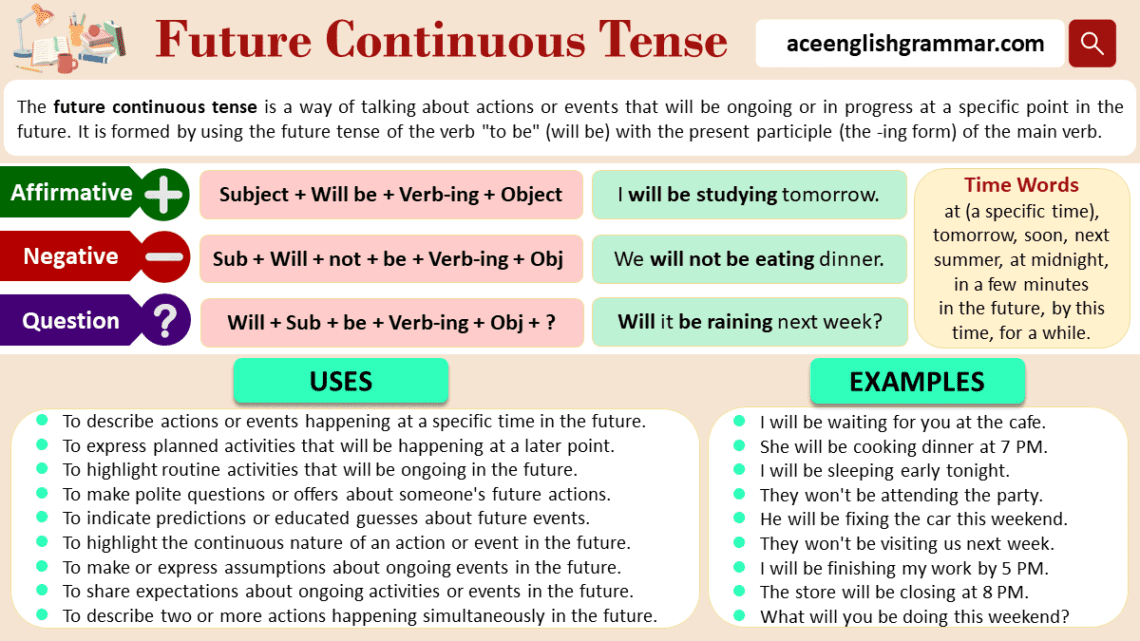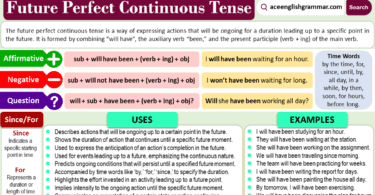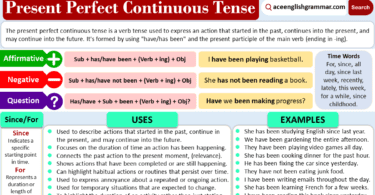The Future Continuous Tense, also called the Future Progressive Tense, describes actions that will be ongoing at a particular time in the future. It’s formed by using “will be” followed by the -ing form of the verb (present participle). This tense is especially useful when we want to talk about plans, ongoing events, or future actions that will be in progress.
Table of Contents
What is Future Continuous Tense?
Future Continuous Tense expresses an action that will happen at a specific point in the future and will be ongoing. It is formed by the structure “will be” plus the present participle of the verb (verb + -ing). This tense is helpful when describing future plans or events that will take place over a period of time.
For example:
“I will be studying tomorrow evening.” Here, the sentence shows that the action (studying) will be in progress at a future point (tomorrow evening).
Positive Form
To form the positive, we use “will be” followed by the verb with -ing. This indicates an action that will be in progress in the future.
- I will be working on the report tonight.
- They will be traveling to Japan next month.
- She will be baking a cake for the event.
Negative Form
In the negative form, “not” is added between “will” and “be”. This shows that the action will not happen at the specified time.
- I will not be attending the meeting tomorrow.
- He will not be joining us for dinner.
- They won’t be staying at the hotel tonight.
Interrogative Form
For questions, “will” comes before the subject, and the sentence ends with the verb in its -ing form.
- Will you be coming to the party?
- Will they be arriving on time?
- What will you be doing this evening?
Structure of Future Continuous Tense
Positive:
Subject + will be + verb + -ing
Negative:
Subject + will not (won’t) be + verb + -ing
Interrogative:
Will + subject + be + verb + -ing?
Time Expressions
The Future Continuous Tense is often paired with specific time expressions, which help clarify when the action will be in progress.
Common time words include:
- At this time tomorrow
- Next week/month/year
- By this time next month
- In the future
- Later tonight
For example:
“At this time tomorrow, I will be working on my project.” This sentence uses the time expression “at this time tomorrow” to specify when the ongoing action (working) will be happening.
Uses of Future Continuous Tense
- Ongoing Future Actions: To describe actions that will be in progress at a certain future time.
Example: “I will be driving to work at 9 AM tomorrow.” - Future Plans: To talk about future events or arrangements that are scheduled to happen.
Example: “We will be attending the concert next week.” - Polite Questions/Offers: Often used to ask politely about someone’s plans.
Example: “Will you be needing my help tomorrow?” - Interrupted Future Actions: Used when one action in the future is interrupted by another event.
Example: “I will be cooking when you arrive.” - Imagining Future Events: It’s helpful in making predictions about what will be happening at a certain time.
Example: “In 50 years, people will be living on Mars.”
Rules for Future Continuous Tense
- Forming the Tense:
Combine “will be” with the verb in its -ing form (present participle).
Example: “She will be reading at 8 PM.” - Adding Not for Negative Sentences:
Insert “not” between “will” and “be” to create negative forms.
Example: “They will not be playing football tomorrow.” - Question Form:
Begin with “will”, followed by the subject, then “be” and the verb in its -ing form.
Example: “Will you be coming to the event?”
Example Sentences
- I will be writing my essay tomorrow evening.
- They will not be visiting us this weekend.
- Will you be using the car tomorrow?
- We will be watching the sunset at 6 PM.
- I won’t be going to the gym later.
FAQs
Q1: What is the Future Continuous Tense?
It’s a verb tense used to describe actions that will be ongoing at a specific time in the future, formed by “will be” plus the present participle of the verb.
Q2: When do we use Future Continuous Tense?
We use it to talk about future actions that will be in progress at a particular moment or time in the future.
Q3: How do you form a Future Continuous sentence?
In positive sentences, use “will be” followed by the -ing form of the verb. For negative sentences, add “not” after “will”.
Q4: Can we use time expressions with Future Continuous Tense?
Yes, time expressions like “tomorrow at this time,” “next week,” or “at 5 PM” are commonly used.
Q5: Can you give some example sentences?
Certainly!
- I will be working late tomorrow.
- Will you be attending the meeting tonight?




